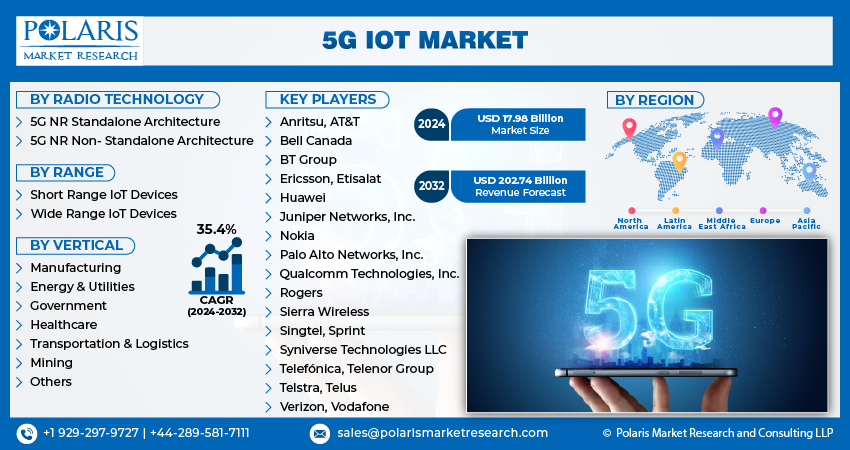The global 5G Internet of Things (IoT) market is poised for transformative growth, having been valued at USD 13.29 billion in 2023. With an anticipated expansion to USD 17.98 billion in 2024 and an impressive USD 202.74 billion by 2032, the market is forecasted to achieve a remarkable compound annual growth rate (CAGR) of 35.4% during this period. The integration of 5G technology with IoT solutions is expected to revolutionize industries by enhancing connectivity, enabling real-time data processing, and fostering the development of innovative applications across various sectors.
The 5G IoT market represents the convergence of ultra-fast wireless communication with the interconnected ecosystem of IoT devices, offering unparalleled opportunities for businesses and consumers alike. Enhanced data speeds, reduced latency, and the ability to connect millions of devices simultaneously are some of the core advantages driving the adoption of 5G IoT solutions.
Market Growth Drivers
Several key factors are fueling the growth of the 5G IoT market:
- Proliferation of IoT Devices
The increasing adoption of IoT devices across industries such as healthcare, automotive, manufacturing, and smart cities is a primary driver of the 5G IoT market. With billions of devices connected globally, the need for reliable, high-speed communication networks like 5G has become critical.
- Advancements in 5G Technology
The rollout of 5G networks has introduced new capabilities, such as enhanced mobile broadband (eMBB), ultra-reliable low-latency communication (URLLC), and massive machine-type communication (mMTC). These features enable seamless data transfer, critical for IoT applications like autonomous vehicles, industrial automation, and remote healthcare.
- Growing Demand for Real-Time Data Processing
Industries increasingly rely on real-time data insights to improve decision-making, optimize operations, and enhance customer experiences. 5G’s low latency and high-speed capabilities support these requirements, driving its adoption in IoT ecosystems.
- Supportive Government Initiatives
Governments worldwide are investing in 5G infrastructure development and promoting IoT adoption to enhance digital transformation. Such initiatives are expected to boost the growth of the 5G IoT market in the coming years.
- Rising Demand for Smart Cities and Industry 4.0
The shift toward smart cities and the adoption of Industry 4.0 principles have accelerated the need for advanced connectivity solutions. 5G IoT facilitates efficient energy management, intelligent transportation systems, and automated industrial processes, contributing to market growth.
𝐂𝐥𝐢𝐜𝐤 𝐡𝐞𝐫𝐞 𝐭𝐨 𝐀𝐜𝐜𝐞𝐬𝐬 𝐭𝐡𝐞 𝐅𝐮𝐥𝐥 𝐑𝐞𝐩𝐨𝐫𝐭:
https://www.polarismarketresearch.com/industry-analysis/5g-iot-market
Key Trends in the 5G IoT Market
- Edge Computing Integration
The integration of edge computing with 5G IoT is gaining traction as it enables faster data processing closer to the source, reducing latency and bandwidth usage. This trend is particularly significant for applications like autonomous driving, telemedicine, and smart manufacturing.
- Adoption of Private 5G Networks
Enterprises are increasingly deploying private 5G networks to ensure secure and reliable connectivity for their IoT applications. These networks offer enhanced control, improved performance, and the ability to customize solutions for specific use cases.
- Emergence of New Use Cases
Innovative use cases are emerging with the combination of 5G and IoT technologies. Examples include drone delivery services, smart agriculture solutions, augmented reality (AR) applications, and advanced logistics systems.
- Focus on Sustainability
Sustainability is becoming a key consideration in the 5G IoT market. Energy-efficient network infrastructure, smart grids, and IoT solutions for resource optimization are gaining prominence as organizations strive to reduce their environmental footprint.
- Collaborations and Partnerships
Collaboration between telecom operators, IoT solution providers, and industry stakeholders is driving the development of innovative 5G IoT solutions. Strategic partnerships are enabling companies to leverage complementary expertise and accelerate market penetration.
Research Scope
The scope of research in the 5G IoT market encompasses various dimensions, including technological advancements, industry-specific applications, regional dynamics, and market segmentation. Researchers are focusing on the following areas:
- Technological Innovation: Exploration of advancements in 5G networks, IoT hardware, and software solutions to identify growth opportunities.
- Vertical Market Analysis: Examination of 5G IoT adoption across industries such as healthcare, automotive, manufacturing, and energy.
- Regional Trends: Analysis of market trends across regions, including North America, Europe, Asia-Pacific, and the Rest of the World.
- Competitive Landscape: Assessment of key players’ strategies, product offerings, and market positioning.
- Regulatory and Policy Impacts: Evaluation of government policies, standards, and regulations influencing the 5G IoT market.
Market Segmentation
By Component
- Hardware: Sensors, actuators, gateways, and other IoT devices compatible with 5G networks.
- Software: Platforms and applications enabling data collection, analysis, and management.
- Services: Managed services, consulting, and system integration solutions.
By Application
- Smart Cities: IoT-enabled infrastructure for smart grids, intelligent transportation, and urban management.
- Industrial IoT: Automation, predictive maintenance, and robotics in manufacturing and supply chain processes.
- Healthcare: Remote patient monitoring, telemedicine, and connected medical devices.
- Automotive: Vehicle-to-everything (V2X) communication, autonomous driving, and smart traffic management.
- Agriculture: Precision farming, livestock monitoring, and resource optimization.
By Connectivity
- Enhanced Mobile Broadband (eMBB): High-speed connectivity for bandwidth-intensive applications.
- Ultra-Reliable Low-Latency Communication (URLLC): Reliable and real-time connectivity for critical applications.
- Massive Machine-Type Communication (mMTC): Connectivity for large-scale IoT deployments with low data rates.
By Region
- North America: Leading the market with early 5G adoption and robust IoT ecosystems.
- Europe: Significant investments in smart city projects and industrial automation.
- Asia-Pacific: Rapid growth driven by expanding 5G networks and increasing IoT device adoption.
- Rest of the World: Emerging opportunities in Latin America, the Middle East, and Africa.
The 5G IoT market is set to redefine the technological landscape, offering unprecedented opportunities for innovation and efficiency across industries. With a robust growth trajectory, driven by advancements in connectivity, the proliferation of IoT devices, and supportive government initiatives, the market is poised to reach USD 202.74 billion by 2032. Industry players must focus on leveraging emerging trends, such as edge computing, private networks, and sustainability, to capitalize on this growth potential. As 5G and IoT continue to converge, businesses that embrace these technologies will be well-positioned to thrive in a hyper-connected future.
𝐌𝐨𝐫𝐞 𝐓𝐫𝐞𝐧𝐝𝐢𝐧𝐠 𝐋𝐚𝐭𝐞𝐬𝐭 𝐑𝐞𝐩𝐨𝐫𝐭𝐬 𝐁𝐲 𝐏𝐨𝐥𝐚𝐫𝐢𝐬 𝐌𝐚𝐫𝐤𝐞𝐭 𝐑𝐞𝐬𝐞𝐚𝐫𝐜𝐡:

